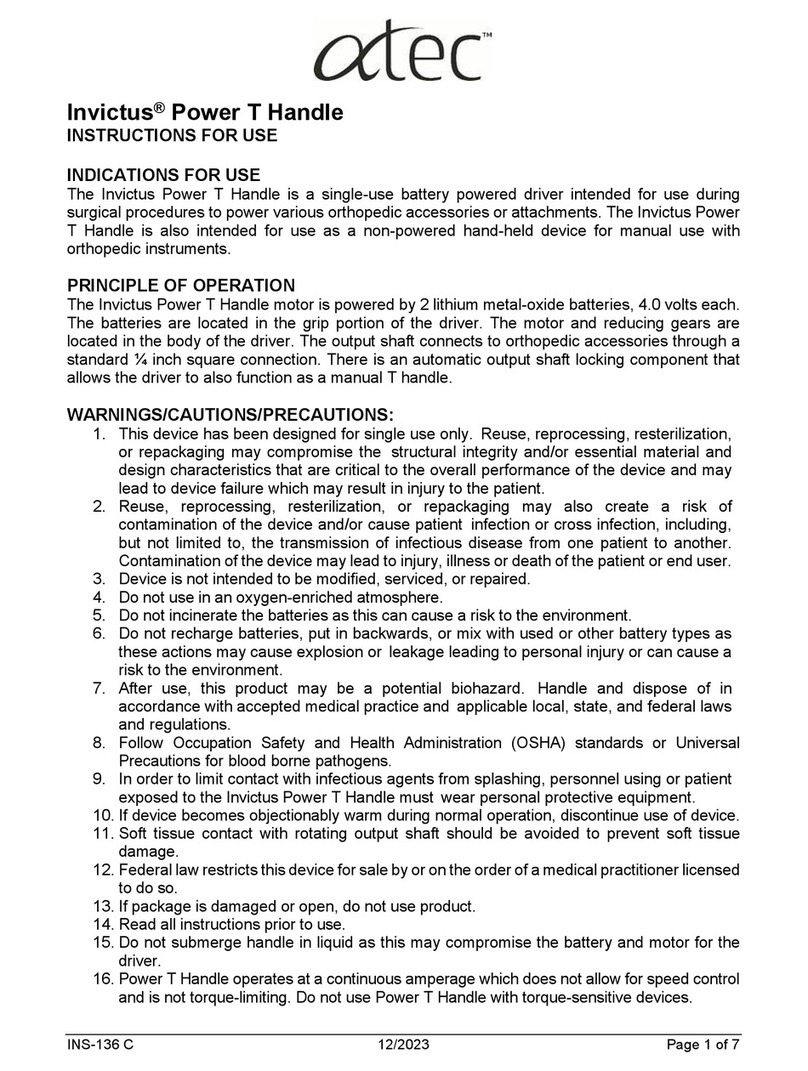INS-108 Rev C 03/2021 Page 2 of 8
WARNINGS:
1. The implants and instruments of the system are provided non-sterile and must be cleaned and sterilized prior
to use. Refer to the CLEANING and STERILIZATION sections.
2. The safetyand effectiveness of thisdevicehasnotbeen established foruse as partofa growing rod construct.
This device is only intended to be used when definitive fusion is being performed at all instrumented levels.
3. The system implants are used only to provide temporary internal fixation during the bone fusion process with
the assistance of a bone graft. A successful result may not be achieved in every instance of use with these
devices. Without solid bone fusion, these devices cannot be expected to support the spine indefinitely and
may fail due to bone-metal interface, rod failure or bone failure.
4. The implants are designed and intended as temporary fixation devices. The devices should be removed after
complete healing has occurred. Devices which are not removed after serving their intended purpose may
bend, dislocate, or break and/or cause corrosion, localized tissue reaction, pain, infection, and/or bone loss
due to stress shielding. Complete postoperative management to maintain the desired result should also follow
implant removal surgery.
5. The product implants are single use devices. Do not reuse. While an implant may appear undamaged, it may
have small defectsor internal stresspatterns that could lead to fatigue failure. Inaddition, the removed implant
has not been designed or validated for the decontamination of microorganisms. Reuse of this product could
lead to cross-infection and/or material degradation as a result of the decontamination process.
6. The instruments in the Kodiak Spinal Fixation System are reusable surgical devices except for the Fascial
Blades, Single Step Stylets, and Guidewires used with the Kodiak Spinal Fixation System, which are single
use only. Single-use instruments are disposable devices, designed for single use and should not be re-used
or re-processed. Reprocessing of single-use instruments may lead to instrument damage and possible
improper function.
7. Do not comingle titanium and stainless steel components within the same construct.
8. The safety and effectiveness of pedicle screw spinal systems have been established only for spinal conditions
with significant mechanical instability or deformity requiring fusion with instrumentation. These conditions are
significant mechanical instability or deformity of the thoracic, lumbar, and sacral spine secondary to severe
spondylolisthesis (grades 3 and 4) of the L5-S1 segment, degenerative spondylolisthesis with objective
evidence of neurological impairment, fracture, dislocation, scoliosis, kyphosis, spinal tumor, and failed
previous fusion (pseudarthrosis). The safety and effectiveness of these devices for any other conditions are
unknown.
9. Based on the fatigue test results, the physician/surgeon should consider the levels of implantation, patient
weight, patient activity level and patient conditions, which may impact the performance of the system when
using this device. Use of these systems is significantly affected by the surgeon’s proper patient selection,
preoperative planning, proper surgical technique, proper selection and placement of implants.
10.Risks identified with the use of these devices, which may require additional surgery, include device component
failure, loss of fixation/stabilization, non-union, vertebral fracture, neurological injury, vascular or visceral
injury.
11.Risk factors that may affect successful surgical outcomes include: alcohol abuse, obesity, patients with poor
bone, muscle and/or nerve quality. Patients who use tobacco or nicotine products should be advised of the
consequences that an increased incidence of non-union has been reported with patients who use tobacco or
nicotine products.
12.The benefit of spinal fusions utilizing any pedicle screw fixation system has not been adequately established
in patients with stable spines. Without solid bone fusion, these devices cannot be expected to support the
spine indefinitely and may fail due to bone-metal interface, rod failure or bone failure.
13.The final operative procedure with the system must include tightening of the set screws in order to maintain
construct integrity using the appropriate instrument(s), e.g., Torque Handle. Failure to tighten the Set Screws
using the recommended instrument(s) could compromise the mechanical stability of the construct. Each
locking mechanism must be rechecked for tightness before closing the soft tissues as noted in the
Intraoperative Management section.


























